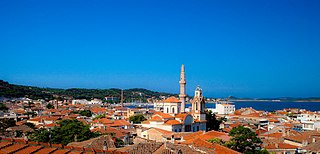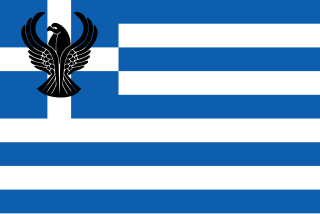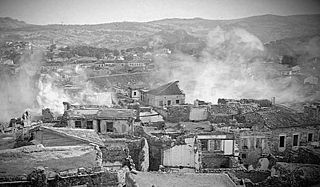
The Armenian genocide was the systematic destruction of the Armenian people and identity in the Ottoman Empire during World War I. Spearheaded by the ruling Committee of Union and Progress (CUP), it was implemented primarily through the mass murder of around one million Armenians during death marches to the Syrian Desert and the forced Islamization of others, primarily women and children.

Otto Viktor Karl Liman von Sanders was an Imperial German Army general who served as a military adviser to the Ottoman Army during the First World War. In 1918 he commanded an Ottoman army during the Sinai and Palestine Campaign. On the whole Sanders provided only limited help to the Ottoman forces.

Ottoman Armenian casualties refers to the number of deaths of Ottoman Armenians between 1914 and 1923, during which the Armenian genocide occurred. Most estimates of related Armenian deaths between 1915 and 1918 range from 600,000 to 1.5 million.

Cunda Island, also called Alibey Island,, Greek Moschonisi, is the largest of the Ayvalık Islands archipelago in Turkey, which was historically called the Εκατόνησα (Hekatonisa) or Μοσχονήσια (Moschonisia) archipelago in Greek. It lies in the Edremit Gulf on Turkey's northwestern coast, off the coast of Ayvalık in Balıkesir Province, Turkey, with an area of 26.8 square kilometres (10 sq mi). It is located 16 kilometres east of Lesbos, Greece.

Ayvalık, formerly also known as Kydonies, is a municipality and district of Balıkesir Province, Turkey. Its area is 305 km2, and its population is 74,030 (2022). It is a seaside town on the northwestern Aegean coast of Turkey. The town centre is connected to Cunda Island by a causeway and is surrounded by the archipelago of Ayvalık Islands, which face the nearby Greek island of Lesbos.

The 1923 population exchange between Greece and Turkey stemmed from the "Convention Concerning the Exchange of Greek and Turkish Populations" signed at Lausanne, Switzerland, on 30 January 1923, by the governments of Greece and Turkey. It involved at least 1.6 million people, most of whom were forcibly made refugees and de jure denaturalized from their homelands.

The Greek genocide, which included the Pontic genocide, was the systematic killing of the Christian Ottoman Greek population of Anatolia, which was carried out mainly during World War I and its aftermath (1914–1922) – including the Turkish War of Independence (1919–1923) – on the basis of their religion and ethnicity. It was perpetrated by the government of the Ottoman Empire led by the Three Pashas and by the Government of the Grand National Assembly led by Mustafa Kemal Atatürk, against the indigenous Greek population of the Empire. The genocide included massacres, forced deportations involving death marches through the Syrian Desert, expulsions, summary executions, and the destruction of Eastern Orthodox cultural, historical, and religious monuments. Several hundred thousand Ottoman Greeks died during this period. Most of the refugees and survivors fled to Greece. Some, especially those in Eastern provinces, took refuge in the neighbouring Russian Empire.

The Special Organization was an intelligence, paramilitary, and secret police organization in the Ottoman Empire known for its key role in the commission of the Armenian deportation. Originally organized under the Ministry of War, the organization was shifted to answer directly to the ruling party Committee of Union and Progress (CUP) in February 1915. Led by Bahaeddin Şakir and Nazım Bey and formed in early 1914 of tribesmen as well as more than 10,000 convicted criminals—offered a chance to redeem themselves if they served the state—as a force independent of the regular army.

The Republic of Pontus was a proposed Pontic Greek state on the southern coast of the Black Sea. Its territory would have encompassed much of historical Pontus in north-eastern Asia Minor, and today forms part of Turkey's Black Sea Region. The proposed state was discussed at the Paris Peace Conference of 1919, but the Greek government of Eleftherios Venizelos feared the precarious position of such a state and so it was included instead in the larger proposed state of Wilsonian Armenia. Ultimately, however, neither state came into existence and the Pontic Greek population was massacred and expelled from Turkey after 1922 and resettled in the Soviet Union or in Macedonia, Greece. This state of affairs was later formally recognized as part of the population exchange between Greece and Turkey in 1923. In modern Greek political circles, the exchange is seen as inextricable from the contemporaneous Greek genocide.

Ottoman casualties of World War I were the civilian and military casualties sustained by the Ottoman Empire during the First World War. Almost 1.5% of the Ottoman population, or approximately 300,000 people of the Empire's 21 million population in 1914, were estimated to have been killed during the war. Of the total 300,000 casualties, 250,000 are estimated to have been military fatalities, with civilian casualties numbering over 50,000. In addition to the 50,000 civilian deaths, an estimated 600,000 to 1.5 million Armenians, 300,000 to 750,000 Greeks, and 300,000 Assyrians, lebanese Maronites 200,000 were systematically targeted and killed by Turkish authorities either via the military or Kurdish gangs. Likewise, starting in 1916, Ottoman authorities forcibly displaced an estimated 700,000 Kurdish people westward, and an estimated 350,000 died from hunger, exposure, and disease.

Ottoman Greeks were ethnic Greeks who lived in the Ottoman Empire (1299–1922), much of which is in modern Turkey. Ottoman Greeks were Greek Orthodox Christians who belonged to the Rum Millet. They were concentrated in eastern Thrace, and western, central, and northeastern Anatolia. There were also sizeable Greek communities elsewhere in the Ottoman Balkans, Ottoman Armenia, Ottoman Syria and the Ottoman Caucasus, including in what, between 1878 and 1917, made up the Russian Caucasus province of Kars Oblast, in which Pontic Greeks, northeastern Anatolian Greeks, and Caucasus Greeks who had collaborated with the Russian Imperial Army in the Russo-Turkish War of 1828–1829 were settled in over 70 villages, as part of official Russian policy to re-populate with Orthodox Christians an area that was traditionally made up of Ottoman Muslims and Armenians.

The Ottoman Committee of Union and Progress was a revolutionary group, secret society, and political party, active between 1889 and 1926 in the Ottoman Empire and in the Republic of Turkey. The foremost faction of the Young Turks, the CUP instigated the 1908 Young Turk Revolution, which ended absolute monarchy and began the Second Constitutional Era. After an ideological transformation, from 1913 to 1918, the CUP ruled the empire as a dictatorship and committed genocides against the Armenian, Greek, and Assyrian peoples as part of a broader policy of ethnic erasure during the late Ottoman period. The CUP and its members have often been referred to as "Young Turks", although the Young Turk movement produced other Ottoman political parties as well. Within the Ottoman Empire its members were known as İttihadcılar ('Unionists') or Komiteciler ('Committeemen').

Sürgün or verb form sürmek was a practice within the Ottoman Empire that entailed the movement of a large group of people from one region to another, often a form of forced migration imposed by state policy or international authority. The practice was also a form of banishment or exile often applied to the elites of Ottoman society, the Pashas. It was most famously used as a method to forcefully displace the native ethnic Armenians by the Young Turk government in 1915, in order to deal with a perceived threat from Armenian partisan groups receiving military support from the Ottoman hostile Russian Empire. These events are listed as one of the methods used to complete the Armenian Genocide.

During the decline and dissolution of the Ottoman Empire, Muslim inhabitants living in Muslim-minority territories previously under Ottoman control often found themselves persecuted after borders were re-drawn. These populations were subject to genocide, expropriation, massacres, religious persecution, mass rape, and ethnic cleansing.

The massacre of Phocaea occurred in June 1914, as part of the ethnic cleansing policies of the Ottoman Empire that included exile, massacre and deportations. It was perpetrated by irregular Turkish bands against the predominantly ethnic Greek town of Phocaea, modern Foça, on the east coast of the Aegean Sea. The massacre was part of a wider anti-Greek campaign of genocide launched by the Young Turk Ottoman authorities, which included boycott, intimidation, forced deportations and mass killings; and was one of the worst attacks during the summer of 1914.

During World War I, Germany was a military ally of the Ottoman Empire, which perpetrated the Armenian genocide. Many Germans present in eastern and southern Anatolia witnessed the genocide, but censorship and self-censorship hampered these reports, while German newspapers reported Ottoman denials of the genocide. Approximately 800 officers and 25,000 soldiers of the Imperial German Army were sent to the Middle Eastern theatre of World War I to fight alongside the Ottoman Army, with German commanders serving in the Ottoman high command and general staff. It is known that individual German military advisors signed some of the orders that led to Ottoman deportations of Armenians, a major component of the genocide.

The 1914 Greek deportations was the forcible expulsion of around 150,000 to 300,000 Ottoman Greeks from Eastern Thrace and the Aegean coast of Anatolia by the Committee of Union and Progress that culminated in May and June 1914. The deportations almost caused war between Greece and the Ottoman Empire and were an important precursor to the Armenian genocide.

On 24 May 1915, on the initiative of Russia, the Triple Entente—Russia, France, and the United Kingdom—issued a declaration condemning the ongoing Armenian genocide carried out in the Ottoman Empire and threatening to hold the perpetrators accountable. This was the first use of the phrase "crimes against humanity" in international diplomacy, which later became a category of international criminal law after World War II.

Differing views of what caused the Armenian genocide include explanations focusing on nationalism, religion, and wartime radicalization and continue to be debated among scholars. In the twenty-first century, focus has shifted to multicausal explanations. Most historians agree that the genocide was not premeditated before World War I, but the role of contingency, ideology, and long-term structural factors in causing the genocide continues to be discussed.

Below is an outline of Wikipedia articles related to the Greek genocide and closely associated events and explanatory articles. The topical outline is accompanied by a chronological outline of events. References are provided for background and overview.




















